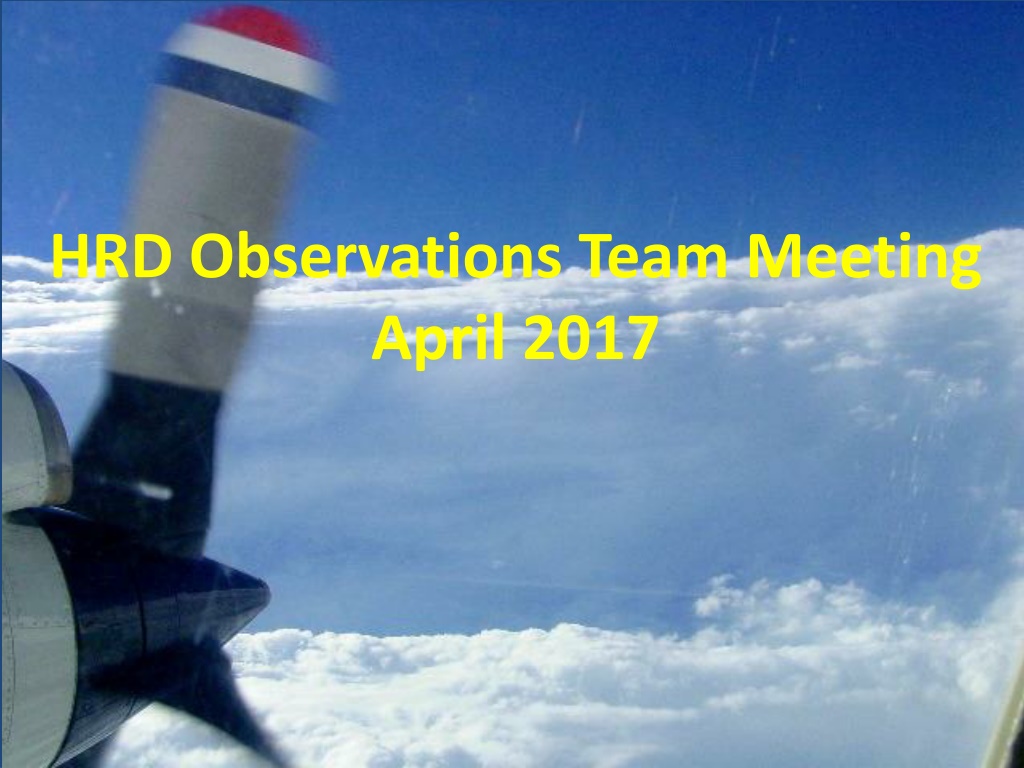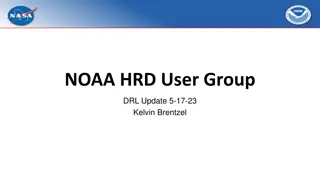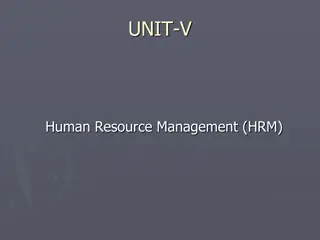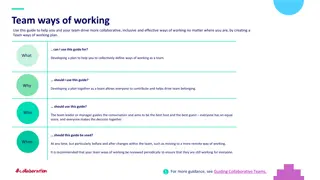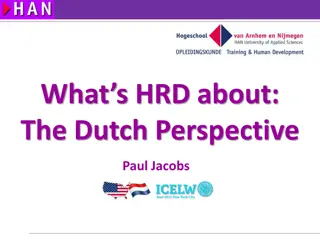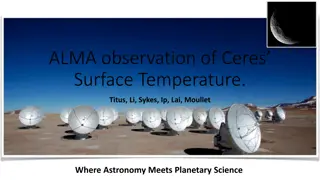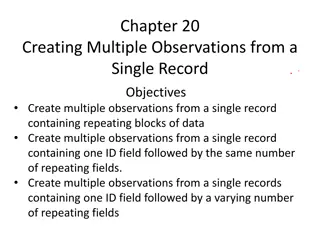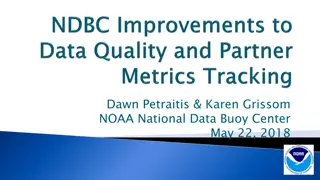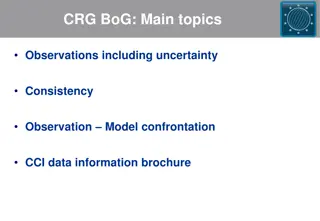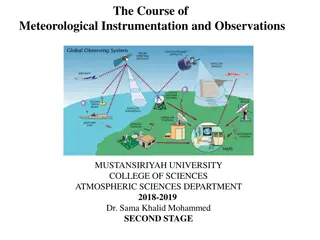HRD Observations Team Meeting April 2017
This document provides insights into the HRD Observations Team Meeting held in April 2017. It includes the agenda items such as HFP 2017 plans, Coyote update, LROSE workshop summary, Weather Research Law update, and discussion on the use of HRD observational datasets. Additionally, it highlights the upcoming events in May/June related to the Hurricane Field Program (HFP). Furthermore, it shares an FYI message from Jeff Smith regarding the development of a new ocean profiler called MASED. Lastly, it mentions the Weather Research and Forecasting Innovation Act of 2017 (H.R. 353), outlining its key sections.
Download Presentation

Please find below an Image/Link to download the presentation.
The content on the website is provided AS IS for your information and personal use only. It may not be sold, licensed, or shared on other websites without obtaining consent from the author.If you encounter any issues during the download, it is possible that the publisher has removed the file from their server.
You are allowed to download the files provided on this website for personal or commercial use, subject to the condition that they are used lawfully. All files are the property of their respective owners.
The content on the website is provided AS IS for your information and personal use only. It may not be sold, licensed, or shared on other websites without obtaining consent from the author.
E N D
Presentation Transcript
HRD Observations Team Meeting April 2017
Agenda 1. HFP 2017 plans (Reasor) 2. Coyote update (Cione) 3. LROSE workshop summary (Dodge, Gamache, Reasor) 4. Recently-passed Weather Research Law 5. Use and relevance of HRD observational datasets (Marks)
2017 HFP Coming up in May/June - Meeting at NHC to get input on priorities (tbd) - AOC transitions to Lakeland early May; N42 phase inspection begins 10 May (4-6 wks) - HFP kick-off meeting at AOML (10AM-12PM on 18 May) - Radar, sonde, and G-IV LPS trainings (late May/early June); Safety courses (tbd) - Field program plan finalized and published (1 June) - HFP briefing at AOC in Lakeland (tbd) HFP Plan - 21 submissions: AIPEX, Arc Cloud, Conv. Burst, Raman Lidar, CYGNSS-SFMR, DWL, ET, GenEx, G-IV SFMR, G-IV TDR, Gliders, High-In. SFMR, Landfall, Eye-Eyewall Mixing, Offshore Windfarm, P-3 TDR, SEF-ERC, SUAVE, Diurnal Cycle, TC in Shear, TC-Ocean - Priorities submitted to AOC for ORM: P-3 TDR, G-IV TDR, DWL, SUAVE and AIPEX Misc. - Yes/no to pursuing Mexican research clearance for Harlingen or La Paz option - Travel cap may mean limited Fed participation in the field this season - Rem: P-3/G-IV flight hrs remaining in FY17 32/25 research, 86/121 NWS - Rem: 66 (HRD), 100 (HFIP), 167 (IR) sondes; 55 AXBTs (some to be used by Otter project)
2017 HFP FYI from Jeff Smith: I ve been assisting as the NOAA technical lead on a SBIR to develop a new ocean profiler, the MASED. This cool sonde will launch from any AVAPS dropsonde tube, and be able to perform multiple ocean profiles at a programmable time interval from minutes to days. The standard data profile includes temperature, current and salinity. Data transfer is via Iridium satellite link. We are nearing the end of Phase II of the SBIR, which will culminate with launching an operational MASED or two in June. The research company is looking for some seed money to further refine the design and manufacture some units. If further development of this project has some interest with your group, I can put you in contact with them.
H.R.353 - Weather Research and Forecasting Innovation Act of 2017 https://www.congress.gov/bill/115th-congress/house-bill/353 TITLE I UNITED STATES WEATHER RESEARCH AND FORECASTING IMPROVEMENT Sec. 101. Public safety priority. Sec. 102. Weather research and forecasting innovation. Sec. 103. Tornado warning improvement and extension program. Sec. 104. Hurricane forecast improvement program. Sec. 105. Weather research and development planning. Sec. 106. Observing system planning. Sec. 107. Observing system simulation experiments. Sec. 108. Annual report on computing resources prioritization. Sec. 109. United States Weather Research program. Sec. 110. Authorization of appropriations. Sec. 413. Hurricane hunter aircraft.
SEC. 102. Weather research and forecasting innovation. (a) Program. The Assistant Administrator for the Office of Oceanic and Atmospheric Research shall conduct a program to develop improved understanding of and forecast capabilities for atmospheric events and their impacts, placing priority on developing more accurate, timely, and effective warnings and forecasts of high impact weather events that endanger life and property.
SEC. 106. Observing system planning. The Under Secretary shall (1) develop and maintain a prioritized list of observation data requirements necessary to ensure weather forecasting capabilities to protect life and property to the maximum extent practicable; (2) consistent with section 107, utilize Observing System Simulation Experiments, Observing System Experiments, Analyses of Alternatives, and other appropriate assessment tools to ensure continuous systemic evaluations of the observing systems, data, and information needed to meet the requirements of paragraph (1), including options to maximize observational capabilities and their cost-effectiveness; (3) identify current and potential future data gaps in observing capabilities related to the requirements listed under paragraph (1); and (4) determine a range of options to address gaps identified under paragraph (3).
SEC. 413. Hurricane hunter aircraft. (a) Backup capability. The Under Secretary shall acquire backup for the capabilities of the WP 3D Orion and G IV hurricane aircraft of the National Oceanic and Atmospheric Administration that is sufficient to prevent a single point of failure. (b) Authority to enter agreements. In order to carry out subsection (a), the Under Secretary shall negotiate and enter into 1 or more agreements or contracts, to the extent practicable and necessary, with governmental and non-governmental entities. (c) Future technology. The Under Secretary shall continue the development of Airborne Phased Array Radar under the United States Weather Research Program. (d) Authorization of appropriations. For each of fiscal years 2017 through 2020, support for implementing subsections (a) and (b) is authorized out of funds appropriated to the Office of Marine and Aviation Operations.
Use and relevance of HRD observational datasets 1. Are we meeting our needs for research in HRD? 2. Are we meeting our needs to support NOAA? NWS? Research community? 3. What is the most effective way to pass on the responsibilities as data custodians to others/successors? 4. Is our data policy still appropriate given the changing observation technologies? 5. How should we insure archival of our unique data sets?
